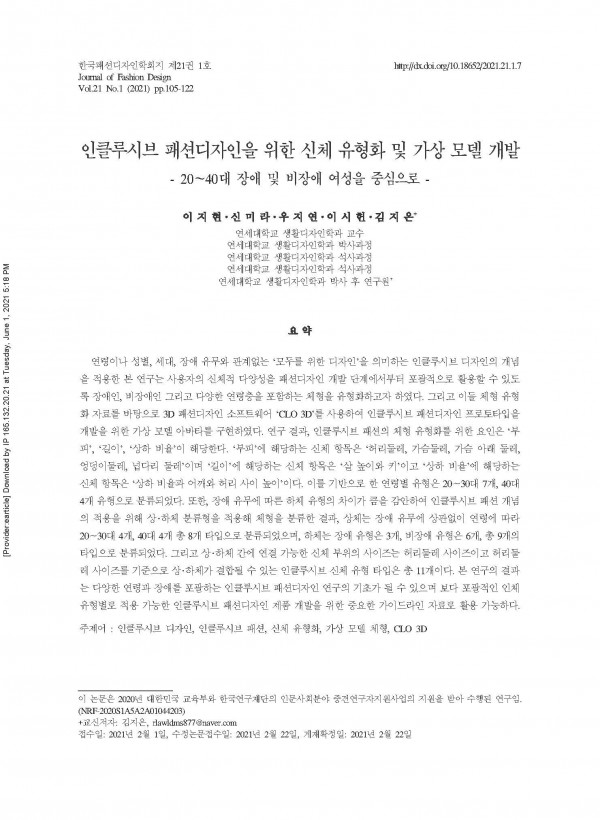논문 | 인클루시브 패션디자인을 위한 신체 유형화 및 가상 모델 개발 - 20∼40대 장애 및 비장애 여성을 중심으로 -
페이지 정보
작성자 관리자 작성일21-06-01 17:22 조회642회 댓글0건관련링크
본문
이지현, 신미라, 우지연, 이시헌, 김지은 (2021). 인클루시브 패션디자인을 위한 신체 유형화 및 가상 모델 개발 - 20∼40대 장애 및 비장애 여성을 중심으로 - , 한국패션디자인학회지, 21(1), 105-122
DOI: http://dx.doi.org/10.18652/2021.21.1.7
ABSTRACT
연령이나 성별, 세대, 장애 유무와 관계없는 ‘모두를 위한 디자인’을 의미하는 인클루시브 디자인의 개념 을 적용한 본 연구는 사용자의 신체적 다양성을 패션디자인 개발 단계에서부터 포괄적으로 활용할 수 있도 록 장애인, 비장애인 그리고 다양한 연령층을 포함하는 체형을 유형화하고자 하였다. 그리고 이들 체형 유형 화 자료를 바탕으로 3D 패션디자인 소프트웨어 ‘CLO 3D’를 사용하여 인클루시브 패션디자인 프로토타입을 개발을 위한 가상 모델 아바타를 구현하였다. 연구 결과, 인클루시브 패션의 체형 유형화를 위한 요인은 ‘부 피’, ‘길이’, ‘상하 비율’이 해당한다. ‘부피’에 해당하는 신체 항목은 ‘허리둘레, 가슴둘레, 가슴 아래 둘레, 엉덩이둘레, 넙다리 둘레’이며 ‘길이’에 해당하는 신체 항목은 ‘샅 높이와 키’이고 ‘상하 비율’에 해당하는 신체 항목은 ‘상하 비율과 어깨와 허리 사이 높이’이다. 이를 기반으로 한 연령별 유형은 20∼30대 7개, 40대 4개 유형으로 분류되었다. 또한, 장애 유무에 따른 하체 유형의 차이가 큼을 감안하여 인클루시브 패션 개념 의 적용을 위해 상・하체 분류형을 적용해 체형을 분류한 결과, 상체는 장애 유무에 상관없이 연령에 따라 20∼30대 4개, 40대 4개 총 8개 타입으로 분류되었으며, 하체는 장애 유형은 3개, 비장애 유형은 6개, 총 9개의 타입으로 분류되었다. 그리고 상・하체 간에 연결 가능한 신체 부위의 사이즈는 허리둘레 사이즈이고 허리둘 레 사이즈를 기준으로 상・하체가 결합될 수 있는 인클루시브 신체 유형 타입은 총 11개이다. 본 연구의 결과 는 다양한 연령과 장애를 포괄하는 인클루시브 패션디자인 연구의 기초가 될 수 있으며 보다 포괄적인 인체 유형별로 적용 가능한 인클루시브 패션디자인 제품 개발을 위한 중요한 가이드라인 자료로 활용 가능하다.
- By applying the concept of inclusive design, which means ‘design for all’ regardless of age, gender, generation, or disability, this study aims to comprehensively reflect the physical diversity of users and intends to categorize body types including non-disabled people and various age. Based on these body type data, we implemented virtual model avatars using 3D fashion design software ‘CLO 3D’. As a result of the study, the factors for the categorization of the body type were ‘volume’, ‘length’, and ‘up and down ratio’. Based on this, the age-specific types were divided into seven types for those who are in their 20s and 30s and four types in their 40s. In addition, considering the large differences in lower body types with and without disabilities, the upper body was classified into eight types, that is, four types in their 20s and 30s, four types in their 40s, and as for the lower body, there were three in the disability types, six in the non-disability types, and nine types in total. In addition, the size of the body parts that can be connected between the upper and lower bodies is waist size, and there are a total of 11 types of body types that can be combined with the upper and lower bodies based on the waist size. The results of this study can be the basis for the study of inclusive fashion design including different ages and disabilities and can be used as an important guideline for developing inclusive fashion design products applicable to more comprehensive human types.
